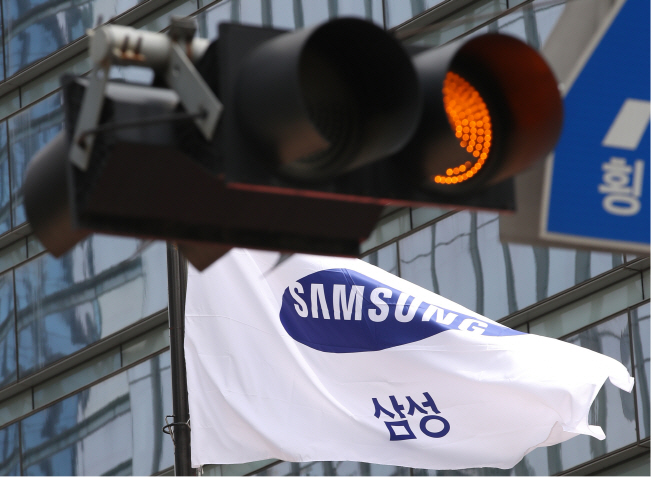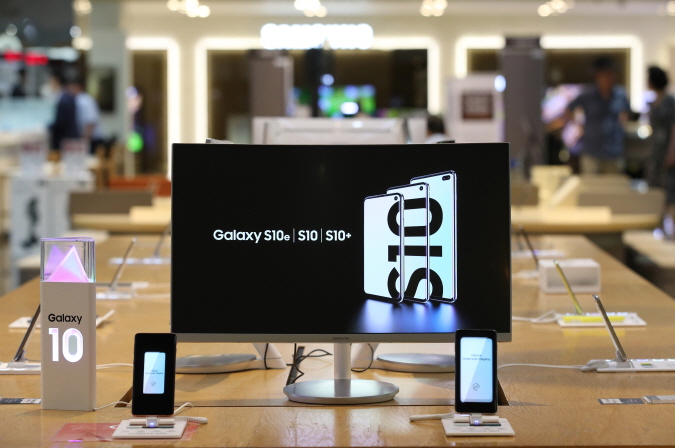
Analysts surmised that Samsung posted improved earnings in the display division because increased sales of premium OLED panels may have offset weak demand for traditional LCD displays. (Yonhap)
SEOUL, Jul. 5 (Korea Bizwire) — Samsung Electronics Co. said Friday its operating earnings more than halved in the second quarter from a year earlier amid the weak memory chip and handset market.
The operating profit was estimated at 6.5 trillion won (US$5.6 billion) in the April-June period, a 56.3 percent drop from a year ago, according to its earnings guidance.
The Korean tech giant expected its overall sales to have fallen 4.2 percent on-year to 56 trillion won in the three-month period.
The figures were above market expectations of 6.07 trillion won, based on the survey conducted by Yonhap Infomax, the financial arm of Yonhap News Agency on 23 Korean brokerage houses. The sales estimate stood at 54 trillion won on average.
Samsung did not break down performances of its respective business divisions, saying it will announce the detailed earnings later this month.
Market watchers said a supply glut in DRAM and NAND flash chips, which account for more than two-thirds of the firm’s sales, dragged down its profitability, expecting the slump to continue in the second half in the wake of Washington’s ban on Huawei, a major client of Samsung’s memory chips.
Market research firm TrendForce anticipated DRAM prices to fall by between 10 and 15 percent in the third quarter, worse than its earlier estimate of a 10 percent decline, as data centers may cut capital expenditures due to rising uncertainties from the trade tension.
It predicted prices of NAND flash chips will also trend down this year.
“As ripples from the U.S. ban continue to spread, Huawei’s shipments of smartphone and server products are feared to face heavy obstacles for the next two to three quarters, impacting peak-season-demand for DRAM products in the second half,” TrendForce said in a report.
“We may see the shipments of NAND flash chips failing to meet expectations for peak season 3Q, and cause contract prices to fall uncontrollably.”
While Samsung earlier predicted its earnings to recover in the second half when inventory levels stabilize and demand picks up in the peak season, analysts anticipated the memory chip business to remain in the downward cycle later this year.
“It is expected to take more time for the memory chip market to get back on track as prices are anticipated to keep sliding in the second half of this year,” Kim Un-ho, an analyst at IBK Investment & Securities, said.
“Chip demand for servers is expected to increase in the latter half, but it will be hovering below earlier estimates.”
The mobile division was also expected to have lackluster profits despite strong sales of Galaxy A series in emerging markets as the average sales prices of the midrange smartphones are cheaper than the flagship line.
Although the world’s largest smartphone maker has upped the ante to invigorate the flattening smartphone market by releasing 5G smartphones in selective markets in the second quarter, including South Korea and the United States, the real benefits will be realized after 2020, analysts predicted.
“Samsung’s smartphone sales are expected to weaken in the third quarter compared with a quarter earlier despite the release of the Galaxy Note 10 in August,” Park Gang-ho, an analyst at Daishin Securities, said.
“Demand for replacing 5G phones is expected to pick up in full swing starting from 2020.”
To boost demand in the premium segment, Samsung plans to unveil its latest phablet, the Galaxy Note 10, on Aug. 7 in New York, while gearing up for the release of the Galaxy Fold, which missed its April schedule due to durability issues of the foldable device.
Adding to the woes is Japan’s export restriction against South Korea of high-tech materials needed for semiconductor and display manufacturing.
Samsung is a major buyer of Japanese chemical companies producing fluorine polyimide used to make flexible OLED displays, as well as resist and etching gas needed in the semiconductor fabrication process.
Industry watchers say the export curbs could disrupt the supply chain of South Korea’s semiconductor and display industries if the Japanese government deliberately takes its time reviewing the process — possibly up to 90 days.
Japan produces about 90 percent of the fluorine polyimide and resist, and 70 percent of the etching gas in the world, forcing Korean buyers to find alternatives if the restrictions are adopted broadly and for an extended period.
Ahead of Japan’s export curbs that went into effect Thursday, Samsung sent a letter to its foundry clients, promising to make sure shipments of their products would be made within their planned supply schedule.
“If the Japanese government does curb exports of the key materials to South Korea, it could disrupt production of Korean chipmakers,” Doh Hyun-woo, an analyst at NH Investment & Securities, said.
“Although Korean companies produce some of the materials, many of them are joint ventures with Japanese companies and their chemical materials have lower degrees of purity than Japanese products.”
In contrast, the display division was a rare bright spot for the Korean tech firm, which has strength in the flexible OLED displays used in premium smartphones.
“The quarterly earnings reflected one-time profit related to displays,” Samsung said in a release, hinting that the better-than-expected earnings were boosted by its display business. It didn’t go into details.
Analysts surmised that Samsung posted improved earnings in the display division because increased sales of premium OLED panels may have offset weak demand for traditional LCD displays.
“Increased adoption of rigid OLED panels by Chinese smartphone makers and surging shipments of the Galaxy A series may have boosted the factory operation rate in the second quarter,” Kim Dong-won, an analyst at KB securities, said.
“The operation rate of the flexible OLED production line may have entered a recovery mode thanks to increased orders from Apple for its iPhones.”
While Samsung is facing headwinds from uncertainties in global trade, some expressed hope that the Korean company could benefit from the U.S. ban on Huawei in its smartphone and telecom equipment business, its key battleground with the Chinese rival.
Analysts said Samsung’s network equipment is anticipated to gain traction if advanced economies join the U.S.-led boycott of Huawei’s equipment for their 5G rollout down the road.
“As the networking equipment division targets enterprise clients, it has more room to improve overall profit than smartphones, which is a positive factor for its IT and mobile division,” No Geun-chang, an analyst at HI Investment & Securities, said.
Samsung, which currently holds a single-digit market share in the networking equipment market, set a goal of capturing 20 percent of the 5G equipment market by 2022.
Shares of Samsung Electronics fell 0.76 percent to 45,650 won, while the benchmark KOSPI gained 0.09 percent. The earnings report was released before the market opened.
(Yonhap)







